氟硅酸钠MSDS
- 格式:doc
- 大小:25.00 KB
- 文档页数:2
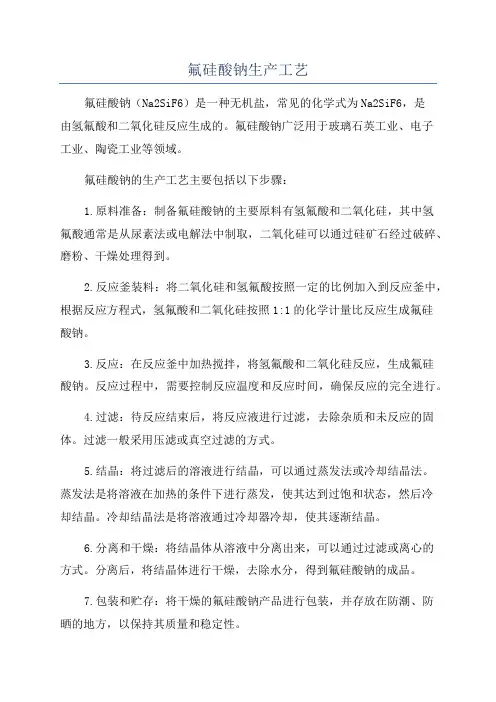
氟硅酸钠生产工艺氟硅酸钠(Na2SiF6)是一种无机盐,常见的化学式为Na2SiF6,是由氢氟酸和二氧化硅反应生成的。
氟硅酸钠广泛用于玻璃石英工业、电子工业、陶瓷工业等领域。
氟硅酸钠的生产工艺主要包括以下步骤:1.原料准备:制备氟硅酸钠的主要原料有氢氟酸和二氧化硅,其中氢氟酸通常是从尿素法或电解法中制取,二氧化硅可以通过硅矿石经过破碎、磨粉、干燥处理得到。
2.反应釜装料:将二氧化硅和氢氟酸按照一定的比例加入到反应釜中,根据反应方程式,氢氟酸和二氧化硅按照1:1的化学计量比反应生成氟硅酸钠。
3.反应:在反应釜中加热搅拌,将氢氟酸和二氧化硅反应,生成氟硅酸钠。
反应过程中,需要控制反应温度和反应时间,确保反应的完全进行。
4.过滤:待反应结束后,将反应液进行过滤,去除杂质和未反应的固体。
过滤一般采用压滤或真空过滤的方式。
5.结晶:将过滤后的溶液进行结晶,可以通过蒸发法或冷却结晶法。
蒸发法是将溶液在加热的条件下进行蒸发,使其达到过饱和状态,然后冷却结晶。
冷却结晶法是将溶液通过冷却器冷却,使其逐渐结晶。
6.分离和干燥:将结晶体从溶液中分离出来,可以通过过滤或离心的方式。
分离后,将结晶体进行干燥,去除水分,得到氟硅酸钠的成品。
7.包装和贮存:将干燥的氟硅酸钠产品进行包装,并存放在防潮、防晒的地方,以保持其质量和稳定性。
需要注意的是,在整个生产过程中,应严格控制反应条件、注意安全防护措施,并进行环境保护措施,减少对环境的污染和危害。
以上就是氟硅酸钠的生产工艺的简要介绍。
具体的生产工艺可能会因厂家、设备等条件而有所差异,需要根据具体情况进行调整和优化。
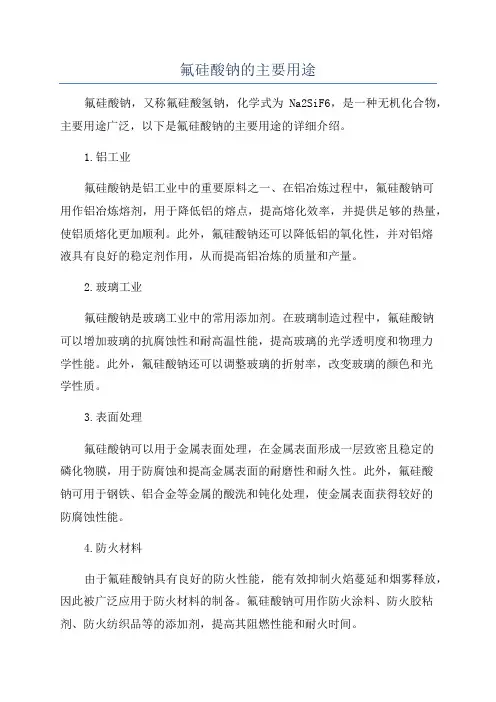
氟硅酸钠的主要用途氟硅酸钠,又称氟硅酸氢钠,化学式为Na2SiF6,是一种无机化合物,主要用途广泛,以下是氟硅酸钠的主要用途的详细介绍。
1.铝工业氟硅酸钠是铝工业中的重要原料之一、在铝冶炼过程中,氟硅酸钠可用作铝冶炼熔剂,用于降低铝的熔点,提高熔化效率,并提供足够的热量,使铝质熔化更加顺利。
此外,氟硅酸钠还可以降低铝的氧化性,并对铝熔液具有良好的稳定剂作用,从而提高铝冶炼的质量和产量。
2.玻璃工业氟硅酸钠是玻璃工业中的常用添加剂。
在玻璃制造过程中,氟硅酸钠可以增加玻璃的抗腐蚀性和耐高温性能,提高玻璃的光学透明度和物理力学性能。
此外,氟硅酸钠还可以调整玻璃的折射率,改变玻璃的颜色和光学性质。
3.表面处理氟硅酸钠可以用于金属表面处理,在金属表面形成一层致密且稳定的磷化物膜,用于防腐蚀和提高金属表面的耐磨性和耐久性。
此外,氟硅酸钠可用于钢铁、铝合金等金属的酸洗和钝化处理,使金属表面获得较好的防腐蚀性能。
4.防火材料由于氟硅酸钠具有良好的防火性能,能有效抑制火焰蔓延和烟雾释放,因此被广泛应用于防火材料的制备。
氟硅酸钠可用作防火涂料、防火胶粘剂、防火纺织品等的添加剂,提高其阻燃性能和耐火时间。
5.化肥工业氟硅酸钠可以作为磷酸肥料的添加剂。
通过将氟硅酸钠与磷酸反应,可以得到氟硅酸磷,作为肥料添加到农田中,提供作物所需的磷元素,并具有延缓磷肥的释放速度和增加磷肥的利用率的作用。
此外,氟硅酸钠还可以用作媒染剂、杀菌剂、防蚀剂、水处理剂等方面的添加剂。
在工业生产和实验室研究中,氟硅酸钠的用途还在不断扩展和发展。
需要注意的是,虽然氟硅酸钠在许多领域中具有重要应用价值,但其含氟化合物在自然环境中具有一定的毒性。
在使用氟硅酸钠时,要严格控制使用剂量和使用条件,避免对环境和人体健康造成不良影响。
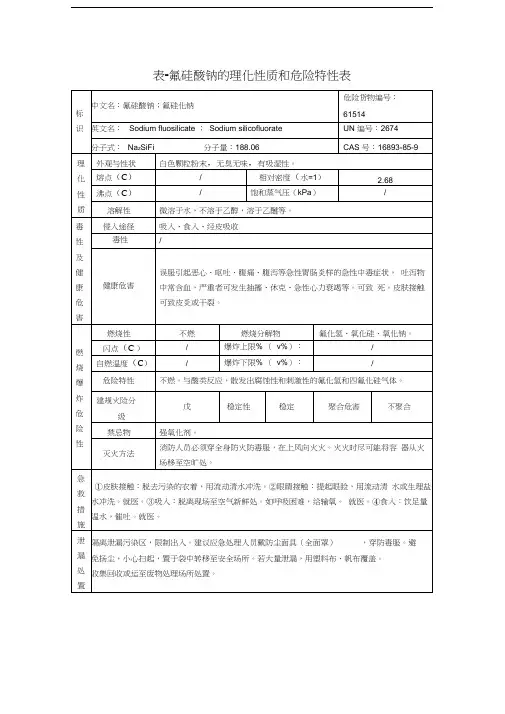
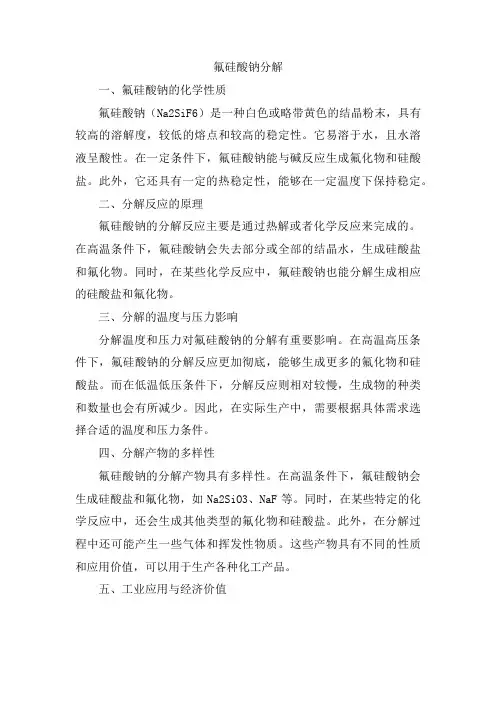
氟硅酸钠分解一、氟硅酸钠的化学性质氟硅酸钠(Na2SiF6)是一种白色或略带黄色的结晶粉末,具有较高的溶解度,较低的熔点和较高的稳定性。
它易溶于水,且水溶液呈酸性。
在一定条件下,氟硅酸钠能与碱反应生成氟化物和硅酸盐。
此外,它还具有一定的热稳定性,能够在一定温度下保持稳定。
二、分解反应的原理氟硅酸钠的分解反应主要是通过热解或者化学反应来完成的。
在高温条件下,氟硅酸钠会失去部分或全部的结晶水,生成硅酸盐和氟化物。
同时,在某些化学反应中,氟硅酸钠也能分解生成相应的硅酸盐和氟化物。
三、分解的温度与压力影响分解温度和压力对氟硅酸钠的分解有重要影响。
在高温高压条件下,氟硅酸钠的分解反应更加彻底,能够生成更多的氟化物和硅酸盐。
而在低温低压条件下,分解反应则相对较慢,生成物的种类和数量也会有所减少。
因此,在实际生产中,需要根据具体需求选择合适的温度和压力条件。
四、分解产物的多样性氟硅酸钠的分解产物具有多样性。
在高温条件下,氟硅酸钠会生成硅酸盐和氟化物,如Na2SiO3、NaF等。
同时,在某些特定的化学反应中,还会生成其他类型的氟化物和硅酸盐。
此外,在分解过程中还可能产生一些气体和挥发性物质。
这些产物具有不同的性质和应用价值,可以用于生产各种化工产品。
五、工业应用与经济价值氟硅酸钠作为一种重要的化工原料,具有广泛的工业应用价值和经济价值。
首先,它可用于制备各种硅酸盐和氟化物,如硅溶胶、白炭黑、氟化钠等。
这些产品在陶瓷、玻璃、涂料、橡胶、石油等领域有广泛应用。
其次,氟硅酸钠还可作为催化剂和助剂用于其他化学反应中,如烷基化反应、酯化反应等。
此外,氟硅酸钠还可用于生产各种功能性材料和复合材料。
六、环境保护与安全问题虽然氟硅酸钠在工业上有着广泛的应用,但在生产和使用过程中也存在一些环境保护和安全问题。
首先,生产过程中会产生大量的废气、废水和固废,如果处理不当会对环境造成污染。
因此,企业需要采取有效的环保措施,如废气处理、废水处理和固废处理等,以减少对环境的污染。
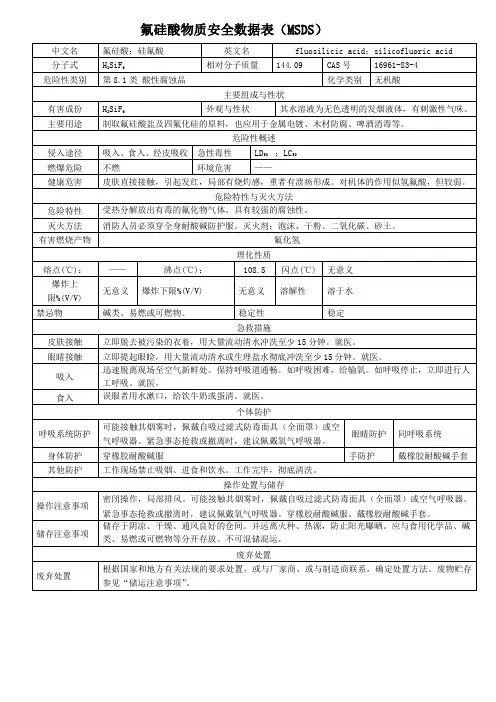
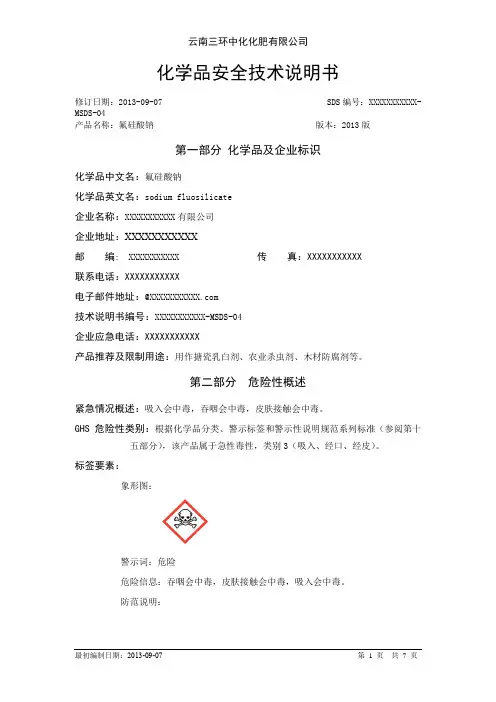
云南三环中化化肥有限公司化学品安全技术说明书修订日期:2013-09-07 SDS编号:XXXXXXXXXXX-MSDS-04产品名称:氟硅酸钠版本:2013版第一部分化学品及企业标识化学品中文名:氟硅酸钠化学品英文名:sodium fluosilicate企业名称:XXXXXXXXXXX有限公司企业地址:XXXXXXXXXXX邮编: XXXXXXXXXXX 传真:XXXXXXXXXXX联系电话:XXXXXXXXXXX电子邮件地址:@技术说明书编号:XXXXXXXXXXX-MSDS-04企业应急电话:XXXXXXXXXXX产品推荐及限制用途:用作搪瓷乳白剂、农业杀虫剂、木材防腐剂等。
第二部分危险性概述紧急情况概述:吸入会中毒,吞咽会中毒,皮肤接触会中毒。
GHS危险性类别:根据化学品分类、警示标签和警示性说明规范系列标准(参阅第十五部分),该产品属于急性毒性,类别3(吸入、经口、经皮)。
标签要素:象形图:警示词:危险危险信息:吞咽会中毒,皮肤接触会中毒,吸入会中毒。
防范说明:预防措施:避免接触眼睛皮肤,操作后彻底清洗。
作业场所不得进食、饮水或吸烟。
戴防护手套/穿防护服。
避免吸入粉尘/烟气/气体/烟雾/蒸气/喷雾。
仅在室外或通风良好处操作。
事故响应:如果发生火灾,根据火灾原因,选择适当的灭火剂灭火。
食入:立即呼叫中毒控制中心或就医。
漱口。
皮肤接触:用大量肥皂水和水清洗。
立即脱去所有被污染的衣服。
被污染的衣服须经洗净后方可重新使用。
如感觉不适,呼叫中毒控制中心或就医。
如吸入:将患者转移到空气新鲜处,休息,保持利于呼吸的体位。
呼叫中毒控制中心或就医。
安全储存:上锁保管。
在通风良好处储存。
保持容器密闭。
废弃处置:建议用焚烧法处置或按照国家和地方法规处置。
物理化学危险:本品不燃。
受热分解产生有毒和腐蚀性的烟气。
与浓酸反应,产生腐蚀性的氟化氢。
健康危害:吸入、吞咽、皮肤接触会中毒。
接触刺激眼睛、皮肤和呼吸道,可能影响钙代谢,造成心脏疾病和功能损害。
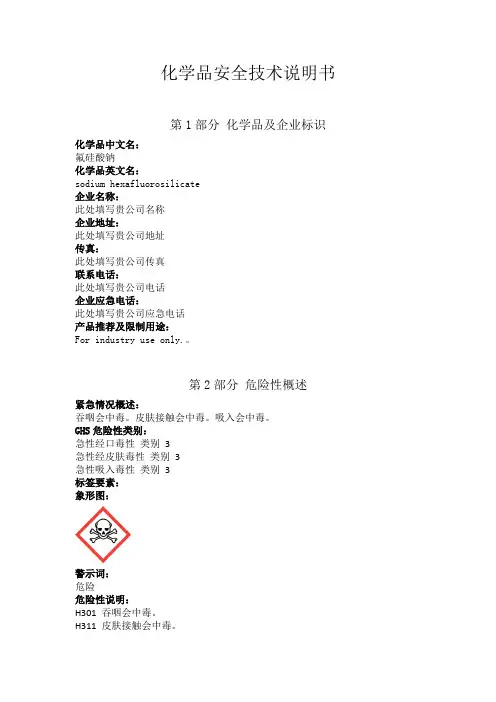
化学品安全技术说明书第1部分化学品及企业标识化学品中文名:氟硅酸钠化学品英文名:sodium hexafluorosilicate企业名称:此处填写贵公司名称企业地址:此处填写贵公司地址传真:此处填写贵公司传真联系电话:此处填写贵公司电话企业应急电话:此处填写贵公司应急电话产品推荐及限制用途:For industry use only.。
第2部分危险性概述紧急情况概述:吞咽会中毒。
皮肤接触会中毒。
吸入会中毒。
GHS危险性类别:急性经口毒性类别 3急性经皮肤毒性类别 3急性吸入毒性类别 3标签要素:象形图:警示词:危险危险性说明:H301 吞咽会中毒。
H311 皮肤接触会中毒。
H331 吸入会中毒。
防范说明:•预防措施:•P264 作业后彻底清洗。
•P270 使用本产品时不要进食、饮水或吸烟。
•P280 戴防护手套/穿防护服/戴防护眼罩/戴防护面具。
•P261 避免吸入粉尘/烟/气体/烟雾/蒸气/喷雾。
•P271 只能在室外或通风良好处使用。
•事故响应:•P301+P310 如误吞咽:立即呼叫解毒中心/医生•P321 具体治疗 ( 见本标签上的…… )。
•P330 漱口。
•P302+P352 如皮肤沾染:用水充分清洗。
•P312 如感觉不适,呼叫解毒中心/医生•P361+P364 立即脱掉所有沾染的衣服,清洗后方可重新使用•P304+P340 如误吸入:将人转移到空气新鲜处,保持呼吸舒适体位。
•P311 呼叫解毒中心/医生•安全储存:•P405 存放处须加锁。
•P403+P233 存放在通风良好的地方。
保持容器密闭。
•废弃处置:•P501 按当地法规处置内装物/容器。
物理和化学危险:无资料健康危害:吞咽会中毒。
皮肤接触会中毒。
吸入会中毒。
环境危害:无资料第3部分成分/组成信息第4部分急救措施急救:吸入: 如果吸入,请将患者移到新鲜空气处。
皮肤接触: 脱去污染的衣着,用肥皂水和清水彻底冲洗皮肤。
如有不适感,就医。
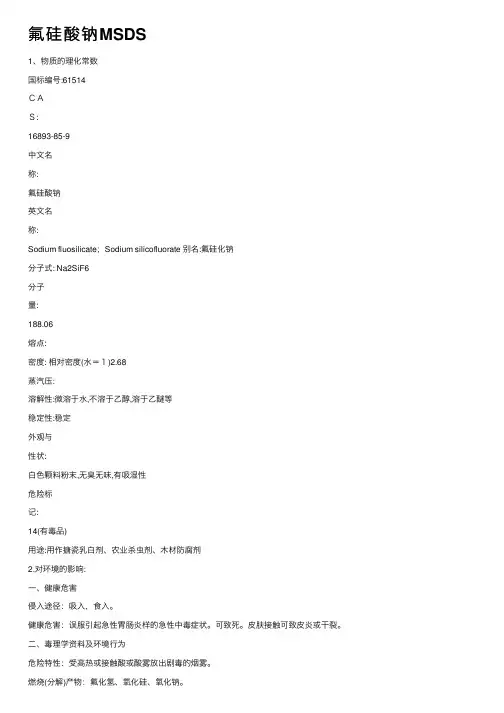
氟硅酸钠MSDS1、物质的理化常数国标编号:61514CAS:16893-85-9中⽂名称:氟硅酸钠英⽂名称:Sodium fluosilicate;Sodium silicofluorate 别名:氟硅化钠分⼦式: Na2SiF6分⼦量:188.06熔点:密度: 相对密度(⽔=1)2.68蒸汽压:溶解性:微溶于⽔,不溶于⼄醇,溶于⼄醚等稳定性:稳定外观与性状:⽩⾊颗料粉末,⽆臭⽆味,有吸湿性危险标记:14(有毒品)⽤途:⽤作搪瓷乳⽩剂、农业杀⾍剂、⽊材防腐剂2.对环境的影响:⼀、健康危害侵⼊途径:吸⼊,⾷⼊。
健康危害:误服引起急性胃肠炎样的急性中毒症状。
可致死。
⽪肤接触可致⽪炎或⼲裂。
⼆、毒理学资料及环境⾏为危险特性:受⾼热或接触酸或酸雾放出剧毒的烟雾。
燃烧(分解)产物:氟化氢、氧化硅、氧化钠。
3.现场应急监测⽅法:4.实验室监测⽅法:离⼦选择性电极法(GB7484-87,⽔质,氟化物)⽯灰滤纸-氟离⼦选择电极法(GB/T15433-95,空⽓,氟化物)5.环境标准:中国(TJ36-79)车间空⽓中有害物质的最⾼容许浓度 1mg(F)/m3前苏联(1975)居民区⼤⽓中最⾼容许浓度0.03mg/m3(最⼤值);0.01mg/m3(⽇均值)6.应急处理处置⽅法:⼀、泄漏处置隔离泄漏污染区,周围设警告标志,应急处理⼈员戴好防毒⾯具,穿化学防护服。
不要直接接触泄漏物,在确保安全情况下堵漏。
避免扬尘,⽤洁净的铲⼦收集于⼲燥洁净有盖的容器中,在专⽤废弃场所深层掩埋。
如⼤量泄漏,收集回收或⽆害处理后废弃。
⼆、防护措施⼯程控制:密闭操作,局部排风。
呼吸系统防护:作业⼯⼈应该佩戴防尘⼝罩。
空⽓中浓度较⾼时,建议佩戴防毒⾯具。
眼睛防护:戴化学安全防护眼镜。
防护服:穿⼯作服。
⼿防护:戴橡⽪⼿套。
其它:⼯作后,淋浴更⾐。
注意个⼈清洁卫⽣。
三、急救措施⽪肤接触:脱去污染的⾐着,⽤⼤量流动清⽔彻底冲冼。
眼睛接触:⽴即翻开上下眼睑,⽤流动清⽔或⽣理盐⽔冲洗。
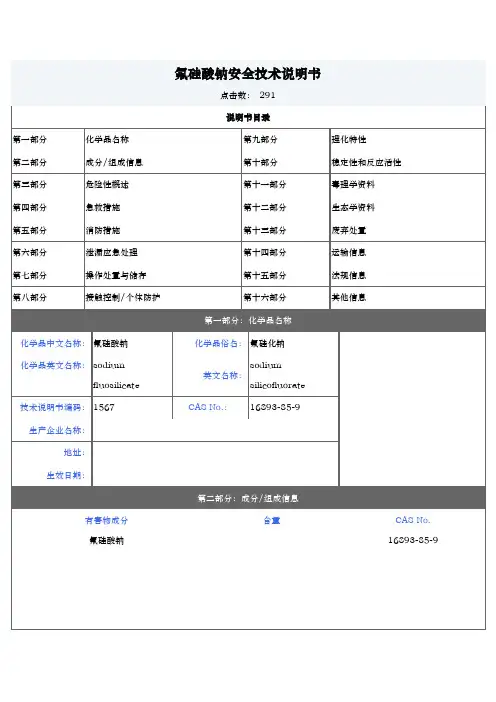
储存注意事项:储存于阴凉、通风的库房。
远离火种、热源。
应与氧化剂、食用化学品分开存放,切忌混储。
储区应备有合适的材料收容泄漏物。
第八部分:接触控制/个体防护
中国MAC(mg/m3): 1[F]
前联MAC(mg/m3): 0.2[F]
TLVTN: ACGIH 2.5mg[F]/m3
TLVWN:未制订标准
监测方法:
工程控制:密闭操作,局部排风。
呼吸系统防护:空气中粉尘浓度超标时,建议佩戴自吸过滤式防尘口罩。
紧急事态抢救或撤离时,应该佩戴空气呼吸器。
眼睛防护:戴化学安全防护眼镜。
身体防护:穿防毒物渗透工作服。
手防护:戴乳胶手套。
其他防护:工作完毕,淋浴更衣。
注意个人清洁卫生。
第九部分:理化特性
外观与性状:白色颗粒粉末, 无臭无味, 有吸湿性。
pH:
熔点(℃):无资料相对密度(水=1): 2.68
沸点(℃):无资料相对蒸气密度(空气=1):无资料
分子式: Na2SiF6分子量: 188.06
主要成分:纯品
饱和蒸气压(kPa):无资料燃烧热(kJ/mol):无意义。

MATERIAL SAFETY DATA SHEETThis information is provided for your protection by:Fluoride Chemicals (Yunnan)Co., Ltd.B, 18F, C2, No. 88, Nanping Road, Kunming, Yunnan,China24 Hour Emergency Assistance: 86-871-3627406Sodium SilicofluorideSection I Product Name and DescriptionSection II Personal Protection InformationSection III Health InformationSection IV Emergency and First Aid ProceduresSection V IngredientsSection VI Physical DataSection VII ReactivitySection VIII Fire and Explosion HazardsSection IX Storage and Special PrecautionsSection X Transportation RequirementsSection XI Emergency Action - Spill or LeakSection IPRODUCT NAME AND DESCRIPTIONDOT Chemical Name:Sodium FluorosilicateSynonyms:Sodium Silicofluoride, Sodium Fluosilicate, Disodium HexafluosilicateChemical Family:Inorganic Fluoride Formula: Na2SiF6CAS Number:16893-85-9 NIOSH Number:8410000Note: N/A indicates Not Applicable where shown.Section IIPERSONAL PROTECTION INFORMATIONRespiratory Protection: A NIOSH approved respirator should be worn.Self-contained breathing apparatus may be required when chemical is heated to decomposition or in a spill area.Eye and Face Protection: Splash-proof goggles should be worn when there is danger of splash from solution containing chemical. Protection against splash or mist from solution containing chemical with 8-inch minimum face shield is recommended. Eye protection should be worn in presence of dry chemical, or solution containing chemical, at all times.Hand, Arm and Body Protection: Impervious gloves should be worn. Protective, impervious clothing should be worn in presence to prevent contact with skin (coveralls, boots, etc.)Other Protective Clothing and Equipment: Protect open wounds. Heating to decomposition requires full protective clothing and self-contained breathing apparatus.Engineering Controls: Adequate ventilation to maintain fluoride concentrations below applicable standards.Section IIIHEALTH INFORMATIONOSHA Permissible Exposure Limit (PEL): 2.5mg/m3(as F)ACGIH Threshold Limit Value (TLV): 2.5mg/m3(as F)Listing in the following:New Jersey "Right to Know" laws - YesToxic Substances Control Act Inventory of Toxic Substances (TSCA) - Yes Workplace Hazardous Materials Information System (WHMIS) - Yes OSHA Health Hazard Classification: Toxic.Primary Route(s) of Entry: Eye and skin contact, inhalationSymptoms of Exposure:Acute: Fluoride dust may cause irritation to eyes and respiratory tract. Swallowing fluoride dust may cause nausea, vomiting, abdominal pain or burning, diarrhea, shortness of breath, difficulty in speaking, thirst, weakness of pulse, disturbed color vision, muscular weakness, convulsions, loss of consciousness and death. Kidney injury and bleeding from injury may occur.Chronic: Repeated exposure above the PEL or TLV to fluoride dust may cause excessive calcification of ligaments of the ribs, pelvis and spinal column. Sclerosis of changes of bones and ligaments can be seen by x-ray. Enzyme system effects and pulmonary fibrosis are reported. Stiffness and limitation of motions may result. Common findings are eye, skin, and mucous membrane irritation, loss of weight, anorexia, anemia, wasting, cachexia, and dental defects. Repeated or prolonged exposure to the skin may cause skin rash.Aggravated Medical Condition: Pre-existing respiratory diseases including asthma and emphysema.toxic Data: 125 mg/kg (Oral - Rat)Section IVEMERGENCY AND FIRST AID PROCEDURESInhalation: If a person breathes in chemical dust, remove exposed person promptly to fresh air. If breathing has stopped, perform artificial respiration. Oxygen should be provided for a person having difficulty breathing (but only administered by an authorized individual) until the person is able to breath easily by themselves. Keep the affected person warm and at rest. Get medical attention as soon as possible.Eye Contact: Flush eyes with large amounts of water, lifting the upper and lower lids at periodic intervals to insure contact of water with all accessible tissue of the eyes and lids. Medical attention should be given as soon as possible, preferably an eye specialist.Skin Contact: Promptly wash the contaminated skin using soap or mild detergent and water. If chemical, or solution containing chemical, soaks through clothing, remove the clothing promptly and wash the skin using soap or mild detergent and water. Medical attention should be given as soon aspossible for all burns, regardless of how minor thy seem.Ingestion: If conscious, give the exposed person large quantities of water immediately. Do NOT induce vomiting. Several glasses of milk may be given for its soothing effect. A physician should be contacted immediately.Note to Physician: Exposed person should be observed for 48 - 72 hours for delayed onset of pulmonary edema.Section VINGREDIENTSComposition PercentageNa2SiF699.00H2O 0.50NaFHF 0.50Section VIPHYSICAL DATAMelting Point:Deco mposes @ 500°C SpecificGravity(H2O=1): 2.679Bulk Density90 lbs/Ft3Percent Volatile by Volume:N/A Vapor Density (Air=1)N/A pH: 3.1Solubility in Water:0.76 grams/100 ml of water @ 25°C2.45 grams/100 ml of water @100°CVapor Density (Air=1):N/AEvaporation Rate:N/A Physical State:Solid, granules Molecular Weight:188.05 Vapor Pressure (mm Hg):N/A Appearance and Odor: White, odorless, granular, crystalline material.Section VIIREACTIVITYStability: Stable.Hazardous Polymerization: Will not occur.Conditions and Materials to Avoid: Contact with strong acids andalkalis,such contact will cause formation of hydrogen fluoride gas. Hazardous Decomposition Products: Temperatures above 500°C, such as fires, will cause decomposition and formation of hydrofluoric acid and fluorine. Section VIIIFIRE AND EXPLOSION HAZARDSFlash Point and Method Used: N/AFlammable Limits - % Volume in Air:Lower N/A Upper N/A Extinguishing Media: This chemical is not flammable, but for fires in area where this chemical is stored, use foam, dry chemicals or CO2.Special Fire Fighting Procedures and Precautions: When this product is heated to decomposition (500°C), it will generate highly toxic gases such as hydrogen fluoride.Auto Ignition Temperature: N/AUnusual Fire and Explosion Hazards: Extreme temperatures, such as fires, will cause decomposition and formation fluorine. Firefighters should avoid all bodily contact, wear full protective clothing and self-contained breathing apparatus.Section IXSTORAGE AND SPECIAL PRECAUTIONSHandling and Storing Precautions: Store in a cool, dry place and away from acids. Use only with adequate ventilation, dust mask or self-contained breathing apparatus. Protective clothing should always be worn. Avoid contact with eyes, skin, and clothing. Keep bag or container closed when not in use. Avoid breathing dust or mist.Ventilation: Provide adequate general and/or local exhaust to maintainvapors below acceptable air level maximums.Other Precautions: Do not get on skin, clothing, or in eyes. Wash off with water. Do not take internally. Do not breathe dust. Keep separated from strong acids and alkalis.Section XTRANSPORTATION REQUIREMENTSDOT Proper Shipping Name:SodiumFluorosilicatePacking Group:IIIDOT Hazard Class: 6.1 (Poison) Subsidiary Hazard Class:N/AIdentification Number:UN 2674 Reportable Quantity:N/APlacarding Requirement:Toxic. EPA Hazardous Substance:NoIMDG Placarding Requirement:Toxic.RCRA Status of Unused Material ifDiscarded:Not ListedHazardous Waste Number:Not ListedWaste Disposal Method: Disposer must comply with federal, state and local disposal or discharge laws.Additional Comments: For International transportation, Sodium Fluorosilicate is regulated by the International Maritime Organization (IMO) and the International Air Transport Association (IATA)for vessel and air movement as a Class 6.1 toxic and NOT marked as a marine pollutant, (MDG pg. 6250). Packaging, marking, labelling and shipping paper descriptions must precisely reflect the regulation for export movement.Section XIEMERGENCY ACTION - SPILL OR LEAKEmergency Action: Keep unnecessary people away. Stay upwind, keep out of low areas. Isolate hazard area and deny entry. Ventilate closed spaces before entering them. We recommend that the user establish a spill prevention, control and countermeasure plan. This plan should include procedures for proper storage as well as containment and clean-up of spills and leaks. The procedures should conform to safe practices and provide for proper recoveryand disposal in accordance with federal, state and local regulation. Contact Chemtrec at 86-871-3627406 for 24-hour emergency assistance.Small Spills: Employees should be trained in safety procedures for storageand handling this product. Any personnel in area should wear a NIOSH approved breathing apparatus and protective clothing. Isolate product spill area. Carefully shovel material and place in clean, dry container and cover. Remove container from spill site and dispose of in accordance with federal, state and local regulations. Contact Chemtrec at 86-871-3627406 for 24-hour emergency assistance.Large Spills: Contact Chemtrec at 86-871-3627406 for 24-hour emergency assistance. Employees should be trained in safety procedures for the storage and handling of this product. Any personnel in area should wear a NIOSH approved breathing apparatus and protective clothing. Isolate product spill area. Carefully shovel material and place in clean, dry container and cover. Remove container from spill site and dispose of in accordance with federal, state and local regulations.DISCLAIMERThe information presented herein is based on data considered to be accurate and that reflects the requirements of the OSHA Hazard Communication Standards in effect as of the date of preparation of this Material Safety Data Sheet. However, no warranty or representation, express or implied, is made as to the accuracy or completeness of the foregoing data and safety information. In addition, no responsibility can be assumed by vendor for any damage or injury resulting from abnormal use, from any failure to adhereto recommended practices, or from any hazards inherent in the nature of the product.。
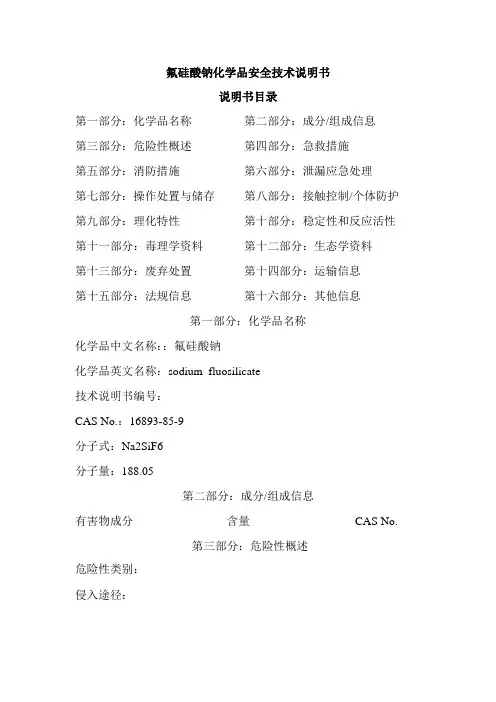
氟硅酸钠化学品安全技术说明书说明书目录第一部分:化学品名称第二部分:成分/组成信息第三部分:危险性概述第四部分:急救措施第五部分:消防措施第六部分:泄漏应急处理第七部分:操作处置与储存第八部分:接触控制/个体防护第九部分:理化特性第十部分:稳定性和反应活性第十一部分:毒理学资料第十二部分:生态学资料第十三部分:废弃处置第十四部分:运输信息第十五部分:法规信息第十六部分:其他信息第一部分:化学品名称化学品中文名称::氟硅酸钠化学品英文名称:sodium fluosilicate技术说明书编号:CAS No.:16893-85-9分子式:Na2SiF6分子量:188.05第二部分:成分/组成信息有害物成分含量CAS No.第三部分:危险性概述危险性类别:侵入途径:健康危害:误服引起恶心、呕吐、腹痛、腹泻等急性胃肠炎样的急性中毒症状,吐泻物中常含血,严重者可发生抽搐、休克、急性心力衰竭等。
可致死。
皮肤接触可致皮炎或干裂。
环境危害:对环境有危害,对水体可造成污染。
燃爆危险:本品不燃,有毒。
第四部分:急救措施皮肤接触:脱去污染的衣着,用流动清水冲洗。
眼睛接触:提起眼睑,用流动清水或生理盐水冲洗。
就医。
吸入:脱离现场至空气新鲜处。
如呼吸困难,给输氧。
就医。
食入:饮足量温水,催吐。
就医。
第五部分:消防措施危险特性:不燃。
与酸类反应,散发出腐蚀性和刺激性的氟化氢和四氟化硅气体。
有害燃烧产物:氟化氢、氧化硅、氧化钠。
灭火方法:消防人员必须穿全身防火防毒服,在上风向灭火。
灭火时尽可能将容器从火场移至空旷处。
第六部分:泄漏应急处理应急处理:隔离泄漏污染区,限制出入。
建议应急处理人员戴防尘面具(全面罩),穿防毒服。
避免扬尘,小心扫起,置于袋中转移至安全场所。
若大量泄漏,用塑料布、帆布覆盖。
收集回收或运至废物处理场所处置。
第七部分:操作处置与储存操作注意事项:密闭操作,局部排风。
操作人员必须经过专门培训,严格遵守操作规程。
氟硅酸钠运输要求氟硅酸钠,化学式为Na2SiF6,是一种无机化合物,具有强烈的腐蚀性。
在工业生产和实验室中,氟硅酸钠常被用作防锈剂、杀虫剂和木材防腐剂等。
由于其具有一定的危险性和腐蚀性,氟硅酸钠的运输需要遵守一定的要求和规定。
一、包装要求氟硅酸钠的包装应符合国家相关法规的要求,采用专用包装容器。
常用的包装材料有塑料桶、铁桶等。
包装容器应具有足够的强度和耐腐蚀性,以保证氟硅酸钠的安全运输。
在包装容器上应明确标注“腐蚀品”、“易燃品”等警示标志,以提醒运输人员注意安全。
二、运输工具要求在氟硅酸钠的运输过程中,应选择适合的运输工具,如危险品运输车辆或专用槽罐车。
运输工具应具备良好的密封性和抗腐蚀能力,以防止氟硅酸钠泄漏或与空气中的水分反应。
运输过程中,应避免与其他化学品混装混载,以防止发生意外事故。
三、运输环境要求氟硅酸钠的运输过程应避免暴晒和高温环境,防止其发生分解、挥发或产生有毒气体。
运输车辆应配备防火设备和泄漏应急处理设备,以应对突发情况。
在运输过程中,应注意避免与水、酸类等物质接触,以免发生剧烈反应。
四、装卸要求装卸氟硅酸钠时,操作人员应穿戴防护服、防护手套、护目镜等个人防护装备。
装卸过程中,应严格遵守操作规程,避免氟硅酸钠泄漏或飞溅。
装卸区域应设有足够的通风设施,以保证操作人员的安全。
五、事故应急处理在氟硅酸钠运输过程中,如发生泄漏或事故,应立即采取应急措施。
首先,应迅速撤离人员,并保持安全距离。
其次,应立即通知有关部门,寻求专业救援。
同时,应尽快采取措施防止泄漏物进入水体或污染土壤,减少对环境的影响。
六、法律法规要求氟硅酸钠的运输应符合国家相关法律法规的要求,如《中华人民共和国危险化学品安全管理条例》等。
运输单位和从业人员应具备相关资质和证书,严格遵守法律法规,确保运输过程安全可靠。
氟硅酸钠的运输要求涉及到包装、运输工具、运输环境、装卸和事故应急处理等方面。
只有严格按照要求进行操作,才能确保氟硅酸钠的安全运输,减少事故的发生。
氟硅酸钠分子量氟硅酸钠(Sodium fluorosilicate),又称六氟硅酸钠,是一种无机化合物,其分子式为Na2SiF6,相对分子质量为188.06。
氟硅酸钠是一种无色结晶,可溶于水,呈酸性溶液。
它是一种常见的工业原料,广泛用于防腐剂、杀虫剂、木材防腐、陶瓷釉料等领域。
一、氟硅酸钠的结构和性质氟硅酸钠的化学式Na2SiF6表示,其中Na代表钠元素,Si代表硅元素,F代表氟元素。
氟硅酸钠的结构由一个硅酸根离子(SiF6)2-和两个钠离子(Na+)组成。
硅酸根离子是由一个硅原子和六个氟原子组成的,呈八面体结构。
氟硅酸钠是一种无色结晶,呈现出潮解性,即能吸湿并溶解于水中。
在水中,氟硅酸钠会发生水解反应,生成氟硅酸(H2SiF6)和钠离子(Na+)。
氟硅酸是一种弱酸,具有腐蚀性。
二、氟硅酸钠的用途1. 防腐剂:氟硅酸钠在农业领域被广泛用作防腐剂,可用于防止谷物和饲料的霉变和腐烂。
2. 杀虫剂:氟硅酸钠可作为杀虫剂使用,例如在灭蚁剂中常见到它的身影。
氟硅酸钠可杀死一些害虫,对于防治害虫起到一定的作用。
3. 木材防腐:由于氟硅酸钠具有防腐蚀的性质,因此在木材防腐处理中也被广泛使用。
将木材浸泡在氟硅酸钠溶液中,可以延长木材的使用寿命。
4. 陶瓷釉料:氟硅酸钠可用作陶瓷釉料的原料,它能够提高釉料的硬度和耐磨性,使陶瓷制品更加耐用。
5. 工业原料:氟硅酸钠还可用作玻璃、搪瓷、水泥等工业原料的添加剂,能够改善产品的质量和性能。
三、氟硅酸钠的安全性氟硅酸钠具有一定的毒性,对皮肤和眼睛有刺激作用,吸入或摄入过量可能导致中毒。
因此,在使用氟硅酸钠时应注意防护措施,避免直接接触皮肤和眼睛,并做好通风工作。
氟硅酸钠还具有环境危害性,对水生生物和土壤有一定的毒性。
在使用和处理氟硅酸钠时,应遵循相关的环保法规,避免对环境造成污染。
四、氟硅酸钠的制备方法氟硅酸钠的制备方法有多种,其中一种常见的方法是将氟化钠(NaF)和六氟硅酸(H2SiF6)反应生成氟硅酸钠。
氟硅酸钠合成法一、氟硅酸钠的性质氟硅酸钠(Na_2SiF_6)为白色结晶粉末,无臭无味,有吸湿性。
微溶于水,不溶于乙醇,可溶于乙醚等溶剂。
在酸中的溶解度比在水中大。
其密度约为2.68g/cm ³,熔点为300°C以上。
它有毒,对呼吸器官有刺激作用。
二、氟硅酸钠的合成法1. 基本原理- 氟硅酸钠的合成通常基于氟硅酸与钠盐的反应。
氟硅酸(H_2SiF_6)可以通过萤石(CaF_2)和石英砂(SiO_2)与浓硫酸反应制得,反应方程式为: - CaF_2+SiO_2 + H_2SO_4→CaSO_4+SiF_4↑ + 2H_2O- 3SiF_4+2H_2O→2H_2SiF_6+SiO_2- 然后氟硅酸与氯化钠(NaCl)反应生成氟硅酸钠,反应方程式为:- H_2SiF_6 + 2NaCl→Na_2SiF_6↓+2HCl2. 合成步骤- 原料准备- 氟硅酸的制备- 首先按照一定比例将萤石粉、石英砂和浓硫酸混合。
萤石粉和石英砂要保证一定的纯度,萤石粉中CaF_2的含量一般要求较高,例如在95%以上。
石英砂中的SiO_2含量也应在90%以上。
浓硫酸的浓度通常为98%。
- 将原料放入反应釜中,反应釜需要耐酸腐蚀,一般采用特制的陶瓷或金属内衬聚四氟乙烯的反应釜。
反应温度控制在200 - 250°C左右,反应过程中会产生大量的气体,需要良好的通风和尾气处理装置,因为产生的四氟化硅(SiF_4)气体有毒。
- 钠盐的准备- 如果使用氯化钠,要选用工业纯以上级别的氯化钠,其杂质含量要低,例如其中的钙、镁等杂质含量应低于一定标准,以免影响氟硅酸钠的纯度。
- 反应过程- 将制得的氟硅酸溶液缓慢加入到含有钠盐(如氯化钠)的溶液中。
反应在搅拌的条件下进行,搅拌速度适中,以保证反应物充分接触又不会引起溶液飞溅。
反应温度一般控制在常温或略高于常温,例如25 - 35°C。
- 在反应过程中,由于生成了氟硅酸钠沉淀,溶液会逐渐变浑浊。
氟硅酸钠高温反应生成物概述氟硅酸钠(Na2SiF6)是一种常见的盐类化合物,其在高温下可以发生不同的反应,并生成多种物质。
本文将介绍氟硅酸钠在高温条件下可能生成的各种物质及其性质。
氟硅酸钠的基本性质氟硅酸钠是一种无色晶体,具有较高的溶解度。
其在水中溶解时会分解为氟硅酸离子(SiF6^2-)和钠离子(Na+)。
这种分解反应常常发生在常温下,但在高温条件下,氟硅酸钠会经历更多的反应,生成不同的产物。
高温下的氟硅酸钠反应1.氟硅酸钠的热分解反应在高温条件下,氟硅酸钠会发生热分解反应,生成氟化钠(NaF)和二氧化硅(SiO2)。
这一反应可以用以下方程式表示:Na2SiF6 → 2 NaF + SiO2产生的氟化钠(NaF)和二氧化硅(SiO2)在高温下可以继续参与其他反应。
2.氟硅酸钠与金属的反应在高温下,氟硅酸钠可以与某些金属反应,生成相应的重金属氟化物和二氧化硅。
具体的反应类型和方程式如下:–氟硅酸钠与钠(Na)的反应:2 Na2SiF6 + 4 Na → 6 NaF +3 SiO2该反应生成氟化钠(NaF)和二氧化硅(SiO2)。
–氟硅酸钠与铝(Al)的反应:3 Na2SiF6 +4 Al → 6 NaF + 3 SiO2 +2 AlF3该反应生成氟化钠(NaF)、二氧化硅(SiO2)和氟化铝(AlF3)。
–氟硅酸钠与镁(Mg)的反应:3 Na2SiF6 + 2 Mg → 6 NaF + 3 SiO2 +MgF2该反应生成氟化钠(NaF)、二氧化硅(SiO2)和氟化镁(MgF2)。
3.氟硅酸钠与酸的反应在高温下,氟硅酸钠和酸反应可以生成酸性盐酸氟硅酸钠(NaHSiF6),输出的方程式如下:Na2SiF6 + 6 HCl → 6 NaCl + H2SiF6该反应中,氟硅酸钠和盐酸(HCl)反应生成氟硅酸氢钠(NaHSiF6),同时生成氯化钠(NaCl)。
氟硅酸钠高温反应生成物的应用氟硅酸钠高温反应生成物在工业中有广泛的应用。
吉林卓尔科技股份有限公司
J I L I N G Z H U O E R T E C H N O L O G Y C O.,LT D
氟硅酸钠材料规格书版本号 A.0 类型化工名称氟硅酸钠物料号文件编号J ZL/
技术要求1、分子式:Na2SiF6
2、分子量:188.05
3、外观:
4、理化性质:
5、Na2SiF6要求含量:≥99%
6、其他杂质含量:水溶解试验:合格
游离酸《0.25
氯化物《0.005
硫酸盐《0.01
碳酸盐《0.01
铁《0.005
重金属《0.005
材料要求分析纯
质量保证1、出货检验报告COA
包装要求
1、内用容量瓶密封,外用纸箱包装或经确认的结实包装。
2、供应商贴在货物内部的标签应该包括以下内容:
①供应商名称;②零件编号;③批号;④材料说明书。
⑤材料数量或者重量存储方式应储存于阴凉、通风、干燥的地方,储存周期按文件《原材料储存期标准》执行。
备注
拟制:审核:批准:。
1、物质的理化常数
国标编号:61514
CA
S:
16893-85-9
中文名
称:
氟硅酸钠
英文名
称:
Sodium fluosilicate;Sodium silicofluorate 别名:氟硅化钠
分子式: Na2SiF6
分子
量:
188.06
熔点:
密度: 相对密度(水=1)2.68
蒸汽压:
溶解性:微溶于水,不溶于乙醇,溶于乙醚等
稳定性:稳定
外观与
性状:
白色颗料粉末,无臭无味,有吸湿性
危险标
记:
14(有毒品)
用途:用作搪瓷乳白剂、农业杀虫剂、木材防腐剂
2.对环境的影响:
一、健康危害
侵入途径:吸入,食入。
健康危害:误服引起急性胃肠炎样的急性中毒症状。
可致死。
皮肤接触可致皮炎或干裂。
二、毒理学资料及环境行为
危险特性:受高热或接触酸或酸雾放出剧毒的烟雾。
燃烧(分解)产物:氟化氢、氧化硅、氧化钠。
3.现场应急监测方法:
4.实验室监测方法:
离子选择性电极法(GB7484-87,水质,氟化物)
石灰滤纸-氟离子选择电极法(GB/T15433-95,空气,氟化物)
5.环境标准:
中国(TJ36-79)车间空气中有害物质的最高容许浓度 1mg(F)/m3
前苏联(1975)居民区大气中最高容许浓度0.03mg/m3(最大值);
0.01mg/m3(日均值)
6.应急处理处置方法:
一、泄漏处置
隔离泄漏污染区,周围设警告标志,应急处理人员戴好防毒面具,穿化学防护服。
不要直接接触泄漏物,在确保安全情况下堵漏。
避免扬尘,用洁净的铲子收集于干燥洁净有盖的容器中,在专用废弃场所深层掩埋。
如大量泄漏,收集回收或无害处理后废弃。
二、防护措施
工程控制:密闭操作,局部排风。
呼吸系统防护:作业工人应该佩戴防尘口罩。
空气中浓度较高时,建议佩戴防毒面具。
眼睛防护:戴化学安全防护眼镜。
防护服:穿工作服。
手防护:戴橡皮手套。
其它:工作后,淋浴更衣。
注意个人清洁卫生。
三、急救措施
皮肤接触:脱去污染的衣着,用大量流动清水彻底冲冼。
眼睛接触:立即翻开上下眼睑,用流动清水或生理盐水冲洗。
就医。
吸入:迅速脱离现场至空气新鲜处。
保持呼吸道通畅。
呼吸困难时给输氧。
呼吸停止时,立即进行人工呼吸。
就医。
食入:给饮牛奶或蛋清。
就医。
灭火方法:水、砂土、干粉、二氧化碳。